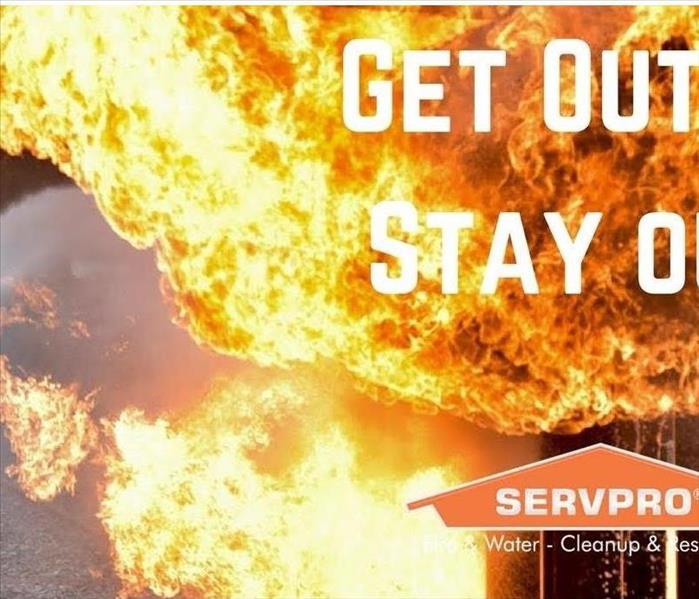Archived Fire Damage Blog Posts
The Vital Importance of Getting Out and Staying Out in a Fire
10/19/2023 (Permalink)
The Vital Importance of Getting Out and Staying Out in a Fire
In times of a fire emergency, every second counts, and your safety should be the top priority. At SERVPRO of Southern Scioto & Lawrence Counties, we want to underscore the crucial significance of getting out and staying out when faced with a fire.
Your Life Is Irreplaceable: In the face of a fire, remember that your life is irreplaceable. Material possessions can be restored, but your well-being is invaluable. This perspective is the cornerstone of fire safety.
Quick and Decisive Action: When a fire breaks out, there's no time to waste. It's imperative to escape immediately and never re-enter a burning building. The heat, smoke, and toxic gases in a fire can be lethal, making re-entry extremely dangerous. Always prioritize your life and the lives of your loved ones.
Preparedness Is Key: Having a well-practiced fire escape plan is essential. Ensure that both your family and coworkers are familiar with this plan. Practice it regularly to ensure everyone knows what to do in the event of a fire. Preparedness can make a significant difference in your ability to evacuate safely.
SERVPRO's Commitment: In the unfortunate event of a fire, remember that SERVPRO is here to support you. Our dedicated team specializes in fire damage restoration. We're committed to making it "Like it never even happened." While property can be restored, your safety is irreplaceable.
Conclusion: In a fire emergency, remember the mantra: Get out and stay out. Your safety is the most crucial consideration, and every moment matters in a fire. By prioritizing quick and safe evacuation, you can protect yourself and your loved ones. Preparedness and having a well-practiced escape plan are essential components of fire safety. In times of crisis, you can count on SERVPRO to assist with fire damage restoration and help you on the path to recovery. Stay safe, be prepared, and remember the importance of getting out and staying out.
Preventing Fires in Garages and Workshops
11/15/2017 (Permalink)
Fires in garages and home workshops are a serious matter. The typical garage or workshop contains a host of flammable materials, from liquids such as gasoline and paint thinner to wood, sawdust and greasy rags. Often, garages and workshops contain heat sources such as water heaters and furnaces that can ignite a fire.
As with most things involving safety, the key to keeping your garage or workshop as fireproof as possible is to make sure you have the right equipment and that you get into the habit of making the safest choices.
Here are three steps to garage and workshop fire prevention that everyone can and should take.
Step 1: Establish Safe Routines
If you develop safe habits, fire prevention will become routine.
- When you cut or sand wood, you create sawdust and wood chips. These small pieces of wood are much more combustible than larger boards. Sweep them up right away and you will eliminate a big source of workshop fires.
- After using paint, stain, finishing oils or solvents, seal the containers and store them in a safe place.
- Properly dispose of oily rags to avoid the possibility of spontaneous combustion. That means placing the rags in a steel bucket with a self-closing lid. Alternatively, hang the rags on a line in a single layer to dry. Keep them far away from heat and fire sources.
Step 2: Practice Safe Storage
Fires require three things: fuel, oxygen and heat. Keep those three things from coming together and you have taken a big step in reducing the chances of a fire. Good storage makes that possible.
- Keep all combustibles away from regular sources of heat or fire, such as water heaters, space heaters, furnaces and boilers.
- Store flammable products such as wood finishes, spray paint and paint thinner in a dedicated storage container with a closed door.
Step 3: Buy Proper Safety Equipment
You don't have to spend much money to buy what you need to alert you about a fire or put a fire out before it spreads.
Heating Safety Tips
11/15/2017 (Permalink)
Heating safety tips
Heating equipment is a leading cause of home fire deaths. Half of home heating equipment fires are reported during the months of December, January, and February. Some simple steps can prevent most heating-related fires from happening.
- Keep anything that can burn at least three feet away from heating equipment, like the furnace, fireplace, wood stove, or portable space heater.
- Have a three-foot “kid-free zone” around open fires and space heaters.
- Never use your oven to heat your home.
- Have a qualified professional install stationary space heating equipment, water heaters or central heating equipment according to the local codes and manufacturer’s instructions.
- Have heating equipment and chimneys cleaned and inspected every year by a qualified professional.
- Remember to turn portable heaters off when leaving the room or going to bed.
- Always use the right kind of fuel, specified by the manufacturer, for fuel burning space heaters.
- Make sure the fireplace has a sturdy screen to stop sparks from flying into the room. Ashes should be cool before putting them in a metal container. Keep the container a safe distance away from your home.
- Test smoke alarms at least once a month.
Safely Using Cords and Electric Outlets
1/25/2017 (Permalink)
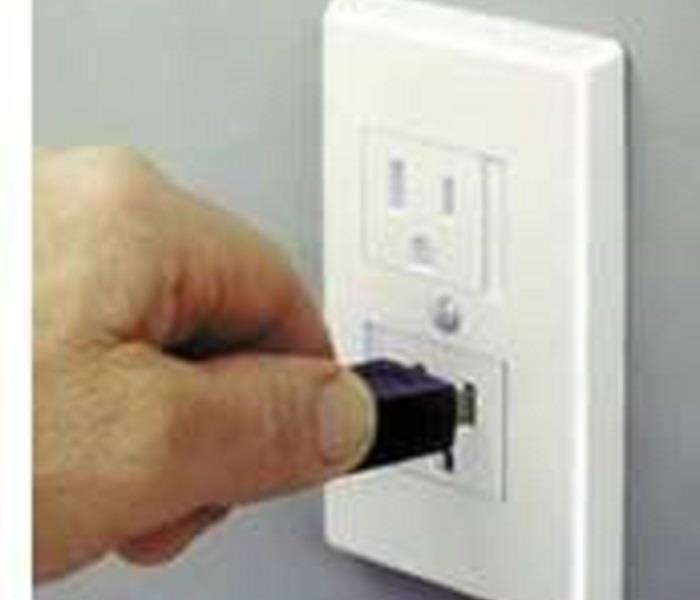 Be smart about how your use your outlets.
Be smart about how your use your outlets.
Electric plug and cord safety
- Only use certified extension cords listed by a recognized certification organization such as Underwriters Laboratories ("UL listed").
- Don't drape electrical cords or wires over radiators, pipes or other metal objects.
- Don't overload wires. Electrical wires are designed to carry only a certain amount of power. Overloading causes wiring to overheat and creates a fire hazard. Make sure the cord is large enough to carry the electricity necessary to operate the tool or appliance.
- Never cut off the third prong. Three-pronged plugs ensure proper grounding for appliances and power tools.
- Replace older cords that have non-polarized receptacles and don't have safety closures. These cords expose young children to shock hazards as well as mouth and burn injuries.
- Use proper extension cords outside. They should be specifically marked for outdoor use. Improper use could result in a fire or shock hazard.
- Check the wattage rating on cords to avoid a potential for a cord overload. Then, add up the wattage ratings of all the products that will be operating at the same time on the cord. If the wattage rating on the cord is lower than the wattage rating of the products, eliminate one load, and check to see if the cord can handle the remaining products. For cords that don't have a wattage rating, multiply the number of amps by 125.
- Don't run extension cords under rugs or carpeting.
- Replace frayed cords.
- Pull the plug, not the cord, to disconnect an appliance.
- Don't overload circuits with too many plugs.
- Install socket guards in all outlets not in use. This helps avoid injury to small children.
Safety Tips on Using Space Heaters
10/10/2016 (Permalink)
 Safe Use of Space Heaters
Safe Use of Space Heaters
Space heaters can be very effective, but they have a bad reputation as fire hazards. Here are some tips for using portable heaters as a safe alternative to heating the entire house.
When Jack Frost comes nipping at your nose, it's time to turn up the heat. For many people, this just means raising the temperature on the central heating system's thermostat. In many cases, though, you only need heat in a small area for a brief time, and it makes more sense to use a space heater than to heat the whole house.
The best way to use a space heater to save money is to only heat one room, but leave the rest of your home cooler. That said, the National Fire Protection Association (NFPA) reminds us that space heaters account for 1/3 of all home fires and 4 out of 5 home heating fire deaths, so paying close attention to safety is a must.
Whatever your reasons for using a space heater, here are tips to help you choose, use, and maintain yours so you can stay safely toasty warm, even when the weather outside is frightful.
SAFETY FIRST
No matter what type or brand of space heater you opt to use, follow these safety tips from the NFPA to reduce the chances of fires and injury:
- Keep anything that can burn, including bedding, furniture, and curtains at least 3 feet away from a space heater.
- Have a three-foot "kid-free zone" around space heaters and never use a space heater in a child's bedroom.
- Run power cords on top of carpet and step over them to avoid abrading the cord. Do not use extension cords.
- Turn off space heaters when going to bed or leaving a room.
- Don't use a space heater in a damp or wet area unless it's specifically made for that purpose.
- Turn space heaters off before leaving the room or going to bed.
- Never put a space heater on a countertop unless it's specifically designed for it.
- Install smoke and carbon monoxide alarms and test monthly.
- Only purchase "UL Listed" heaters which display the UL mark on their label. This is an independent organization which tests for safety.
- Don't use gas- or oil-burning space heaters indoors, only outdoors or in spaces open to the outdoors like tents or porches.
- Read and follow all manufacturer's directions for your space heater.
HOW THEY WORK
Space heaters heat you and the room they occupy in two ways: through radiant heat and convection. Radiant heat is like the warmth you feel when sunlight hits your skin. The closer you are to the space heater, the more of the radiant warmth you'll feel. Convection happens when air surrounding the heater is heated. That hot air rises toward the ceiling, pulling surrounding cool air toward the heater, where that air is heated and also begins to rise. Air at the ceiling then begins to cool and fall, until it's drawn toward the heater once again. This is called a convection loop and, while air toward the ceiling will tend to feel warmer, the convective loop will eventually help to heat the whole room. A heater with an integrated fan will naturally spread more of the heat farther from the heater than relying on convection alone, warming a room more evenly and quickly.
GAS- AND OIL-BURNING SPACE HEATERS
Gas/propane/kerosene space heaters, due to the fact that they produce dangerous combustion gases from burning fuel, should only be used in well-ventilated areas open to the outdoors. This includes areas like tents, screened porches, or new construction homes before the windows and doors are installed. It's best to find a model with a low-oxygen shut-off or oxygen depletion sensor. This safety feature automatically detects when oxygen levels are getting dangerously low in a space, and stops fuel from flowing to the heater, shutting off the flame.
Output for gas- and oil-burning space heaters is measured in British Thermal Units (BTUs). Smaller heaters may have outputs of 4,000 to 9,000 BTUs, which is enough to heat a 200 square-foot tent. Medium-sized heaters will have outputs of 12,000 to 30,000 BTUs, which will heat a space of 600-800 square feet. Larger, commercial grade propane heaters combine propane heat with a powerful electric fan to heat much larger spaces. These units can reach 150,000 to 200,000 BTUs and can heat spaces over 3,000 square feet.
Caution: While "vent-free" gas heaters for residential use do exist, they are only safe if very carefully monitored and maintained. The safety of vent-free units relies on all of the catalytic and safety elements to be clean and in good working order to function properly at all times. If sensors or elements become dusty or dirty, the performance of a vent free unit can be compromised. Even with a properly maintained unit, burning of gas creates not only dangerous combustion gases, but also a surprising amount of water vapor. Aside from safety issues, excessive use of a vent-free gas heater indoors can result in moisture problems like mold, mildew, and condensation damage of wooden windows. Ideally, all gas heaters for indoor use should have sealed combustion chambers which are properly vented to the outdoors.
ELECTRIC SPACE HEATERS
For indoor use, electric models come in many shapes and sizes, but all work in a similar way. They pass electricity through a poorly conducting substance, which resists the electricity passing through it, producing heat. That's why this type of heat is also called "resistance heating." Regardless of whether the heater uses wire, ceramic, quartz, or radiator-type elements, they all work essentially the same way. Some will use a highly reflective backing to concentrate radiant heat in one direction. Ceramic and quartz heaters aim to keep the surface of the heater cool to the touch.
The best electric space heaters employ safety features like a tip-over switch, overheat sensor, and touch sensor (which shuts the unit off if the grill is touched, to prevent burns), to make them as safe as possible. A space heater that features a longer, heavy-duty power cord will mean you won't need an extension cord. Under-sized and frayed power cords are a major source of fire danger.
To determine how much heat an electric space heater will produce, look at the output, which is measured in watts. Generally speaking, outputs range from 400 to 1,500 watts. Most modern models will allow you to adjust the output over a given range.
One of the more advantageous features on an electric space heater is a built-in fan. A built-in fan will spread heat over a wider area as it circulates air through the heater and the room. An integrated fan also means that a heater will heat up an area faster. Space heaters with a thermostat will automate the heater's operation, so you don't have to continually turn it on and off manually to keep a space from getting too warm for comfort. Larger units may even include faux wood cabinets and faux flames for a warmer, fireplace-like look.
THE LONG RUN
If you've turned to a space heater because your home is constantly cold and drafty in the winter, you may end up spending more money on energy in the long run than necessary. Electric space heaters are inherently inefficient as a heating source. As a matter of fact, the Department of Energy's EnergyStar program doesn't certify space heaters in the EnergyStar program for this reason. A central heat pump or gas furnace, even an older model, is likely much more efficient at heating your home. That's why it's important not to use a space heater as anything more than a temporary bandage for spot heating. Instead, solve the real problem: the poor efficiency of your home's shell. Spend a modest amount of money to insulate and air-seal your home to stop cold air infiltration and retain heat from your existing central heat system. Improving the energy efficiency of your home's shell will save you money and make your home a more comfortable and safer place to live in the long run.
Smoke Detectors
10/3/2016 (Permalink)
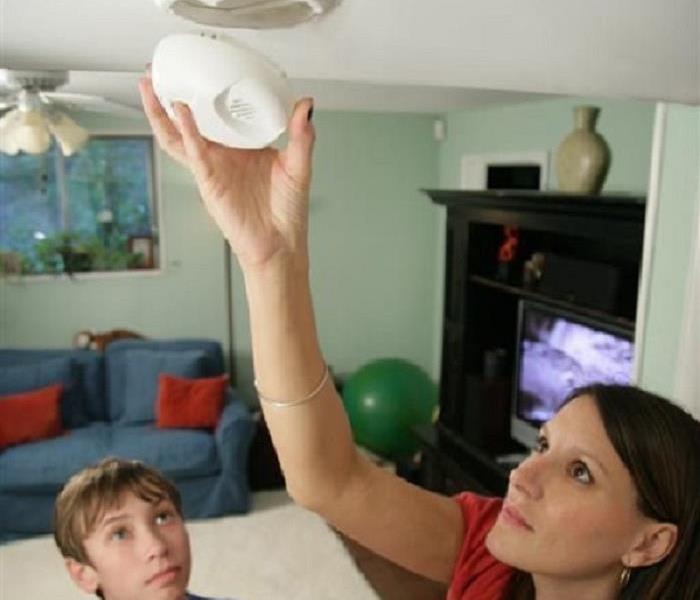 In addition to a home fire escape plan, a working smoke alarm can give your family the early warning they need to get out of your home safely if ther
In addition to a home fire escape plan, a working smoke alarm can give your family the early warning they need to get out of your home safely if ther
Having smoke detectors in your home should be a no-brainer. After all, the consequences of not getting your family out of your burning home in time is pretty obvious, and smoke detectors are fairly inexpensive, readily available, and easy to install.
Smoke Detector Statistics
The importance of smoke detectors make the results of a 2008 phone survey easy to understand. It found that 96% of households in the United States reported that they had at least one smoke detector.
Unfortunately, the results of that smoke detector survey isn't corroborated by the fact that smoke detectors aren't found in just over 30% of home fires.
More smoke detector statistics:
About two-thirds of the deaths in home fires are in homes that either didn't have a smoke detector (40%) or didn't have a working smoke detector (23%).
Just over two-thirds of people report having battery-only smoke detectors, even though hard-wired smoke detectors with a battery backup are thought to work better and are more likely to sound an alarm during a fire.
Many people don't know that they should replace their smoke detector every ten years.
Most smoke detectors don't work because the smoke detector battery is dead or has been removed or disconnected.
Smoke Detector Tips
Fires are one of the leading causes of death in children. In 2007, 477 children died in fires, almost all of them home fires, which makes it important to learn about fire safety and prevention, with smoke detectors being a key part of your home fire safety plan.
You usually can't just put one smoke detector in your home and think you have done all you can do, though.
To keep your family safe, you should:
Install a smoke detector in every bedroom of your home and in the hall that leads to one or two bedrooms, and make sure there is at least one on each floor of your home, even in your basement. You should usually avoid putting a smoke detector in an unheated attic and garage.
Interconnect all of your smoke detectors, a feature on most newer hard-wired smoke detectors and wireless smoke detectors. Interconnected smoke detectors will all sound an alarm when any one of them detects smoke or a fire.
Choose a hard-wired smoke detector that has a battery backup, so that it will work even if the power goes out. Hard-wired smoke detectors are reported to be more reliable in fires than those that are powered by batteries alone.
Get a smoke detector that has strobe lights that flash and/or vibrates if there is someone with hearing loss in your home.
Be sure your smoke detectors are installed properly, either in the center of a ceiling (although away from ceiling fans), or on the wall, at least 6 to 12 inches below the ceiling, and away from air vents, windows, or other high air flow areas.
Choose a combination or dual photoelectric and ionization smoke detector, since each type responds best to different types of fires, or install each type of smoke detector in your home and interconnect them. In general, ionization smoke detectors are best for detecting flaming fires, while photoelectric smoke detectors are best for detecting smoldering fires.
Replace your smoke detector batteries at least once a year and especially when you hear the warning signal that the battery is low. It might be even better to replace the batteries whenever you change your clock at the beginning or end of Daylight Saving Time.
Test your smoke detector each month and replace it if it doesn't work or if it is already 8 to 10 years old.
Regularly clean your smoke detector according to your smoke detector's instructions, which usually involves vacuuming around the outside of the smoke detector when you change the batteries.
Move any smoke detector that causes too many nuisance alarms -- for example, if it routinely goes off when someone is cooking.
Consider getting a smoke detector that includes a recordable voice announcement, which some experts think may be more helpful in waking children versus standard beeping smoke detectors.
Since your smoke detectors are simply early warning signals of a fire in your home, to be safe you also need a good home fire escape plan so that you can take advantage of that early warning and extra time and quickly get your family out of your home.
Best Smoke Detectors
Although there are many brands and types of smoke detectors, the best smoke detector is going to be one that is properly installed and has certain features, including that it:
- is hard-wired with a battery backup.
- can be interconnected with all of the other smoke detectors and carbon monoxide detectors in your home.
- has dual photoelectric and ionization sensors (although it may be best to install an interconnected photoelectric smoke detector near the kitchen and near any bathrooms, since steam may trigger false alarms in the ionization sensor of dual sensor and ionization smoke detectors).
- has a mute or hush button to temporarily silence false alarms.
- includes a compliance label from a recognized testing laboratory, such as the Underwriters Laboratories (UL) and/or National Fire Protection Association (NFPA).
- At this time, the only smoke detector that seems to have all of those features is the Kidde PI2010 hard-wired, dual sensor smoke alarm.
If you have a home security system, you may even be able to add smoke detectors and heat sensors to your security system so that your security monitoring company can notify you and the fire department if there is a fire in your home.
Smoke Detectors vs. Smoke Alarms
It is easy to get confused by all of the terms used when talking about smoke detectors, such as dual sensors, interconnected, ionization, and so on.
One thing that shouldn't be confusing is the difference between smoke detectors and smoke alarms. The two terms are often used interchangeably, but technically they are different. A smoke alarm actually consists of a smoke detector, which senses the smoke, and an alarm-sounding device to alert you that it detected smoke nearby. In addition to the smoke detector sensor in smoke alarms, separate smoke detector sensors are available that can be connected to fire control panels or other alarm systems.
However, practically speaking, if you go to the store to buy a smoke detector or smoke alarm, you will be getting the same thing.
Sources:
National Fire Protection Association. Smoke Alarm Basics. Accessed October 2010.
U.S. Consumer Product Safety Commission. Your Home Fire Safety Checklist. Accessed October 2010.
National Fire Protection Association. "U.S. Experience with Smoke Alarms and Other Fire Detection/Alarm Equipment" by Marty Ahrens, September 2009.
National Center for Injury Prevention and Control. 10 Leading Causes of Unintentional Injury Deaths, United States, 2007.
Fire Safety & Candles
9/26/2016 (Permalink)
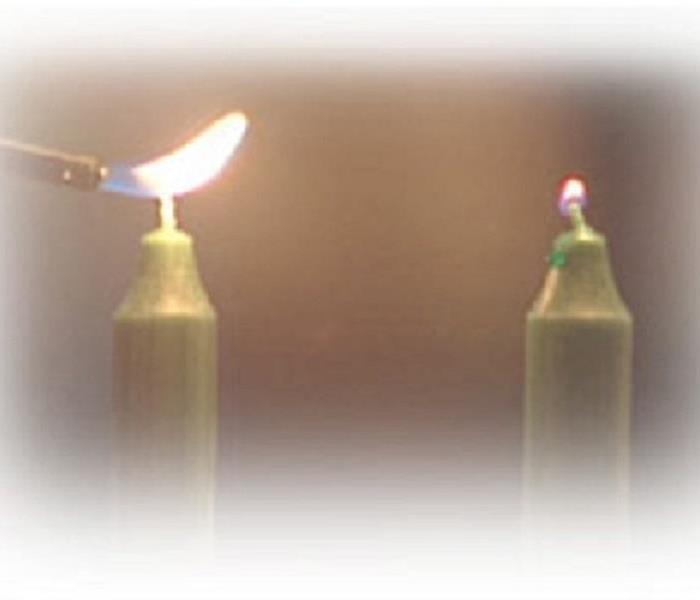 Candles are lovely but safety must come first!!!
Candles are lovely but safety must come first!!!
There’s a special beauty and tranquility to candles, but a lighted candle is also an open flame, and a potential fire hazard if not carefully monitored. In fact, accidental candle fires account for approximately four percent of all U.S. residential fires.
A study by the U.S. Consumer Product Safety Commission suggests that 85 percent of candle fires could be avoided if consumers followed three basic safety rules:
- Never leave a burning candle unattended.
- Never burn a candle on or near anything that might catch fire.
- Keep candles out of the reach of children and pets.
The National Candle Association urges consumers to always follow the basic rules of fire safety when burning candles.
What Makes a Safe & Quality Candle?
NCA invites you to view the webinar, What Makes a Safe & Quality Candle?. This webinar is designed to to educate and inform the retail community on candle basics, safety standards, and testing of candle products. This is a must for compliance personnel and candle buyers.
In this webinar, you will learn:
- An Overview of Candle Basics: Wax and wick types, the difference between dyes and pigments, why fragrance does more than just smell nice, and how changing just one of these elements affects the entire candle.
- The ASTM Safety Standards in Plain English: What it means when a flame is too high, what “secondary ignition” and “end of useful life” mean, and the requirements for glass and plastic containers, candle accessories, warning labels and more.
- What to Ask For and Expect from Your Test Lab: What determines if a candle passes or fails the ASTM standards, the common causes of test failures, and what to do if you think you need additional testing.
- Plus: Tips for Success and Q&A
How to Burn a Candle Safely
Before lighting
- Trim the wick to ¼ inch each time before burning. Long or crooked wicks can cause uneven burning, dripping or flaring.
- Always use a candleholder specifically designed for candle use. It should be heat resistant, sturdy, and large enough to contain any drips or melted wax.
- Burn candles in a well-ventilated room.
- Place the candleholder on a stable, heat-resistant surface. This will also help prevent possible heat damage to counters and table surfaces and prevent glass containers from cracking or breaking.
- Keep the wax pool clear of wick trimmings, matches and debris at all times.
- Avoid drafts, vents or air currents. This will help prevent rapid or uneven burning, sooting, and excessive dripping.
- Follow the manufacturer’s recommendations on burn time and proper use.
While burning
- Never touch or move a burning candle. Never move a votive or container candle when the wax is liquefied.
- Don’t burn a candle all the way down. For a margin of safety, discontinue burning a candle when 2 inches of wax remains (1/2 inch if in a container).
- Place burning candles at least three inches apart from one another. This is to make sure they don’t melt one another, or create their own drafts that will cause the candles to burn improperly.
- Extinguish a candle if the flame becomes too high or flickers repeatedly. Let the candle cool, trim the wick, and check for unwanted drafts before re-lighting.
- Always keep the candle within your sight. If you are going to leave the room, be sure to first blow out all candles.
- Always burn candles in a well-ventilated room. Don’t burn too many candles in a small room or in a “tight” home where air exchange is limited.
- Never use a candle as a night light.
- Be very careful if using candles during a power outage. Flashlights and other battery-powered lights are safer sources of light during a power failure. Never use a candle during a power outage to look for things in a closet, or when fueling equipment – such as a lantern or kerosene heater.
- Never burn a candle on or near anything that can catch fire. Keep burning candles away from furniture, drapes, bedding, carpets, books, paper, flammable decorations, etc.
- Keep candles out of the reach of children and pets. Do not place lighted candles where they can be knocked over by children, pets or anyone else.
When extinguishing
- Use a candle snuffer to extinguish a candle. It’s the safest way to prevent hot wax from splattering.
- Never use water to extinguish a candle. Water can cause the hot wax to splatter and might break a glass container.
- Make sure the candle is completely out and the wick ember is no longer glowing before leaving the room.
- Don’t touch or move the candle until it has completely cooled.
- Never use a knife or sharp object to remove wax drippings from a glass holder. It might scratch, weaken, or cause the glass to break upon subsequent use.
Download a complete list of candle safety rules.
Candle Fire Statistics
Nearly 10,000 residential fires are caused each year by the careless or inappropriate use of candles.
The National Candle Association urges consumers to always keep a burning candle within sight, keep candles away from anything combustible, and to keep candles out of the reach of children and pets.
- These bedroom fires caused 32% of deaths associated with candle fires and 47% of associated injuries.
- On average, 25 home candle fires are reported per day.
- Falling asleep was a factor in 11% percent of the home candle fires and 30% of the associated deaths.
- More than half (58%) of home candle fires occurred when some form of combustible material was left or came too close to the candle.
- December is the peak time of year for home candle fires. In December, 11% of home candle fires began with decorations, compared to 4% the rest of the year.
Power Strips: Their Uses and Hazards
6/13/2016 (Permalink)
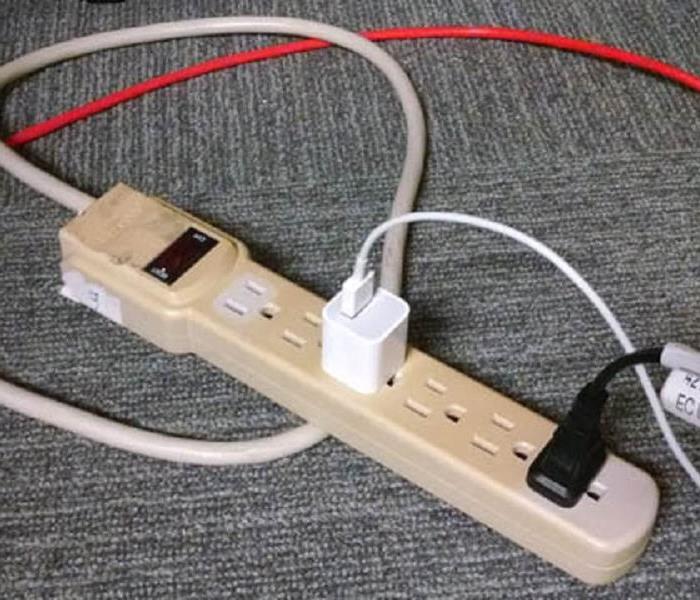 Do not let this be a fire hazard!!!!!
Do not let this be a fire hazard!!!!!
A power strip is a length of electrical sockets attached to the end of a flexible cable that plugs into an electrical receptacle. It is used where electrical appliances in proximity demand more wall receptacles than are available. Inspectors may encounter these on the job while inspecting older homes that lack enough permanent electrical wall receptacles for the needs of today's families. Inspectors who understand the proper uses and limitations of power strips can advise their clients of a potential electrical hazards caused by their misuse. Power strips range in appearance from plastic-coated heads to banks of plug-in outlets encased in large metal boxes, often accompanied by LED switches that indicate when the units are turned on. Some models include a push button that automatically trips if the strip becomes too hot for safe operation. Inspectors can check for the following defective conditions:
“daisy-chaining,” where power strips or surge protectors have been plugged into other power strips and/or extension cords. The supply of available electrical outlets or receptacles in some older buildings may be insufficient, which encourages some homeowners to interconnect surge- protected power strips and/or extension cords. Such an arrangement violates National Electrical Code (NEC) and Occupational Safety and Health Administration (OSHA) regulations because the strip or wall receptacle may become overloaded, resulting in failure or fire;
the power strip is “permanently secured to building structures, tables, work benches or similar structures,” according to the Underwriters Laboratories (UL). Observe the photo at right where InterNACHI inspector David Nasser encountered an obviously dangerous condition;
routing of power strip cords through walls, ceilings, floors or similar openings;
overloading, which may be result in fire or electrocution, and may be caused by the following unsafe conditions:one wall receptacle serves multiple high-use power strips;the power strip serves an excessive number of appliances; andthe power strip serves high-voltage items that are not intended to be plugged into ancillary power sources, such as refrigerators, microwaves or space heaters.
wound or knotted cords. Power strip cords should be straight while in use;
no UL sticker describing the power strip as a “relocatable power tap.” Unlisted items have not been tested for safety and may contain defects such as insufficient protective coating over the wires;
the plug is hanging out of the receptacle. Plugs should be inserted fully into the receptacle so that no part of the metal prongs are exposed;
melted, burned, frayed, discolored or otherwise damaged wires. Discard any cord with exposed wires, cracks or splices;
the device is hot to the touch. If the power strip feels hot, unplug it immediately;
it is located in an area where air circulation is limited, which may lead to overheating, such as beneath carpeting or behind furniture;
it is located in a moist environment (see photo at right);
it is used as permanent wiring, which is defined as wiring used for a period greater than 90 days, according to the U.S. Office of Compliance;
its grounding wire has been cut off to fit into an ungrounded electrical receptacle;
its cord length is excessive, as this may present a trip hazard. According to the UL, “The length of the power-supply cord, as measured from the outside surface of the enclosure of the relocatable power tap to the plane of the face of the attachment plug, should not exceed 25 feet (7.62 m) nor be less than 1.5 feet (0.46 m).” Other sources, however, warn against power strip cords of shorter lengths; and
it is in use at a construction site, such as a building site for a new home, to power high-voltage equipment;
it is in use at a healthcare facility to power medical equipment. The UL states that power strips “have not been investigated and are not intended for use with general patient-care areas or critical patient-care areas of healthcare facilities.”Note that while power strips are designed to distribute electricity, they do not regulate power flow or block electrical spikes or surges. Surge protection is incorporated into some power strips, but it should never be assumed that a power strip offers surge protection without inspecting the unit for the proper UL designation. The misconception that power strips are also surge protectors can lead to costly damage to electrical equipment during a power surge.
In summary, power strips are lengths of electrical sockets that allow multiple appliances to be powered; however, as with all types of extension cords, they should be used sparingly and temporarily with small appliances and electronics, rather than as a substitute for a permanent wall receptacle. Inspectors who observe their improper use may wish to warn their clients of a potential shock or fire hazard.
Southern Scioto & Lawrence Smoke and Soot Cleanup
4/27/2016 (Permalink)
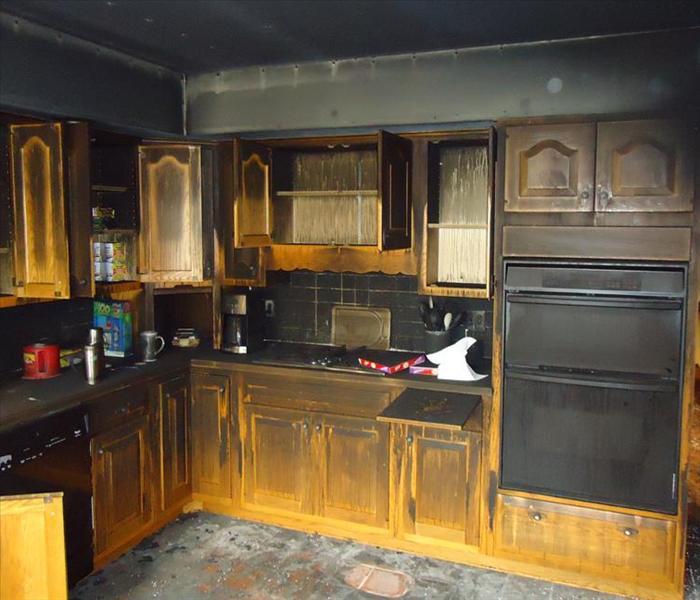 Smoke and Soot Damage Can Cause a Pervasive Odor in Your Southern Scioto & Lawrence Counties Home.
Smoke and Soot Damage Can Cause a Pervasive Odor in Your Southern Scioto & Lawrence Counties Home.
Smoke and soot is very invasive and can penetrate various cavities within your home, causing hidden damage and odor. Our smoke damage expertise and experience allows us to inspect and accurately assess the extent of the damage to develop a comprehensive plan of action.
Smoke and soot facts:
- Hot smoke migrates to cooler areas and upper levels of a structure.
- Smoke flows around plumbing systems, seeping through the holes used by pipes to go from floor to floor.
- The type of smoke may greatly affect the restoration process.
Different Types of Smoke
There are two different types of smoke–wet and dry. As a result, there are different types of soot residue after a fire. Before restoration begins, SERVPRO of Southern Scioto & Lawrence will test the soot to determine which type of smoke damage occurred. The cleaning procedures will then be based on the information identified during pretesting. Here is some additional information:
Wet Smoke – Plastic and Rubber
- Low heat, smoldering, pungent odor, sticky, smeary. Smoke webs are more difficult to clean.
Dry Smoke – Paper and Wood
- Fast burning, high temperatures, heat rises therefore smoke rises.
Protein Fire Residue – Produced by evaporation of material rather than from a fire
- Virtually invisible, discolors paints and varnishes, extreme pungent odor.
Our Fire Damage Restoration Services
Since each smoke and fire damage situation is a little different, each one requires a unique solution tailored for the specific conditions. We have the equipment, expertise, and experience to restore your fire and smoke damage. We will also treat your family with empathy and respect and your property with care.
Have Questions about Fire, Smoke, or Soot Damage?
Call Us Today – 1-740-534-9210





 24/7 Emergency Service
24/7 Emergency Service